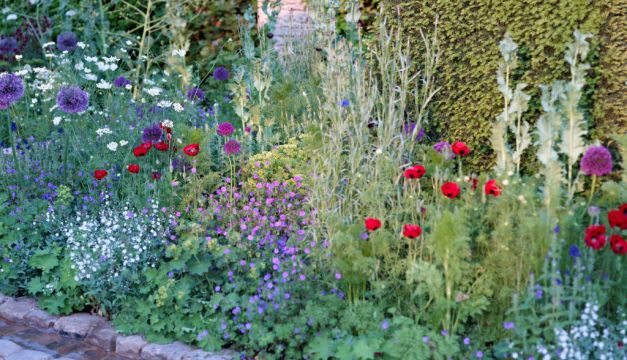Looking to reduce your carbon footprint in your outdoor space this year? Low-carbon gardens are going to be among the highlights of this year’s Chelsea Flower Show in London, but what exactly are they?
Well, they favour planting over hard landscaping, creating a softer, more heavily planted space which is usually much more environmentally friendly and “will also pay back with a bounty of wildlife that you can enjoy”, explains Harry Holding, award-winning designer of this year’s No Adults Allowed Chelsea Flower Show garden.
But it’s more than that. You need to use a minimum amount of energy to create a low-carbon garden, while the materials, products and contents of the garden must have a low embedded carbon footprint, the total amount of carbon (or energy) that was used to create, process and transport the product.
Chelsea Gold Medal winner Tom Massey, designer and author of RHS Resilient Garden (DK), whose WaterAid Garden at Chelsea this year will use resilient planting and cutting-edge technology to deal with a changing climate, explains that the choice of hard landscaping, types of plants, use of reclaimed materials and water conservation all play their part if you want a low-carbon garden.
Hard landscaping
“You have to think to what extent you are going to hard landscape your garden. Hard materials have a much higher carbon footprint than soft (plants and soils) landscaping, but they can vary quite widely in carbon footprint,” Massey says.
“Concrete, for instance, has a much higher carbon footprint than gravel. It all comes down to the amount of energy that it takes to produce the material. Concrete has a high cement content and cement is a high-energy material to produce.”
Natural stone has a low embodied carbon footprint, because of the small amount of processing the material needs to reach its final state. It’s essentially taken from the ground, processed by sawing or knapping (shaping) or carving, and then is ready for use. There’s not a huge amount of process needed to produce it, he explains.
Timber – used in decking and furniture – can have a negative carbon impact if the trees are grown in a sustainable way and sourced close to home, he continues. “Trees are being cut down from woodlands that are managed sustainably, so when they cut trees down, they will replace the trees and won’t cut an excessive number down.”
Re-use materials
“If you are re-using, repurposing or recycling materials, the carbon has already been expended in making it, it’s served its life elsewhere and then you are using it again, so you’re further reducing the carbon footprint.”
“There is a debate on durability versus carbon impact,” he continues.
“Softwood timber, for example, is low-carbon and can potentially come from a forest that is absorbing carbon, but isn’t going to last very long in your garden, so you’ll have to replace it more frequently than, say, natural stone or a pre-cast concrete paver, which might last 100 years without having to be relaid.”
Look for anything that is reclaimed or has had a life before – like reclaimed stone or gravel – and try to source materials near to where you live, he suggests.
“If you buy gravel, for instance, from a supplier who is based in Ireland and nearer to your area, that’s going to have a lower carbon footprint than purchasing gravel from, say, China, which has been shipped halfway across the world to reach you.”
Soft landscaping
“Plants can actually really help with your carbon footprint. Trees draw carbon from the air and can lock carbon into the soil through their roots, and it’s the same with all plants,” Massey explains.
Making sure you have lots of soft areas where you have plenty of plants will help your carbon footprint, but try not to disturb the ground too often by excessive digging or constant replanting because that will release the carbon from the soil, he says.
Perennials, which you leave in the ground, will ultimately create less of a carbon footprint than annuals, which are dug up and disposed of once they have finished flowering.
“Think about the balance between hard and soft landscaping. Do you need to have a massive patio or could you break it up a bit and have more areas of planting?”
Make the most of trees
View this post on Instagram
“The best trees for carbon sequestration will generally be those that grow large and fast – so planes, tulip trees, black walnuts,” says fellow Chelsea award-winning landscape designer Tom Stuart-Smith, whose National Garden Scheme garden at this year’s show will celebrate the majesty of native woodland, with a hazel coppice and underplanting.
Consider hedging
If you live in an urban area, some hedging is good at capturing particular pollution as well as carbon, such as yew or Cotoneaster franchetii, Massey suggests. Evergreen species with dense foliage and rough or hairy leaves are good at capturing pollution particles, he adds.
Allow grass to grow longer
This will give it more time to draw carbon from the air and benefit pollinators when wild flowers bloom in it.
Use small plants
If you plant small plants you’ll cause less disturbance to the soil and have more chance of the plant establishing, says Massey. Alternatively, grow from seed. “Reducing the production of plants, the plastic in the pots, the time it takes to transport, the watering, the storage, all that costs money, energy and carbon.”
If you don’t have time to grow from seed, buy bare root plants (when they are dormant in winter), which generally come wrapped in newspaper, not planted in a plastic pot full of compost, and you can plant them straight into the ground, he advises.
Harvest rainwater
View this post on Instagram
“Disconnect your downpipes and store the rainwater in water butts, which is going to be lower carbon than running mains water, which requires a lot of processing to make it safe to drink,” says Massey.







